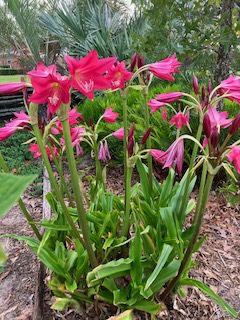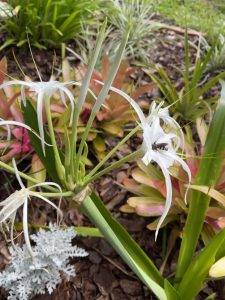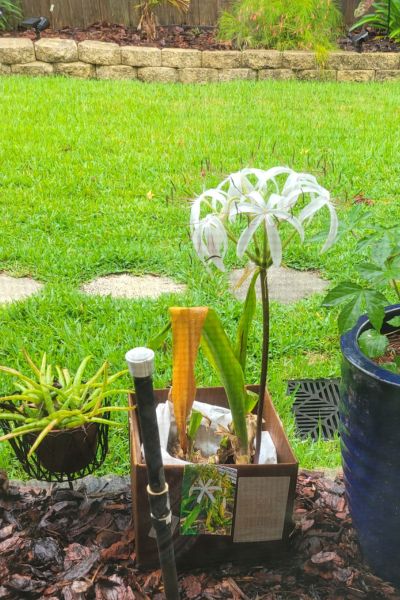
There is no better month for pink flowers than June and no better flower than crinums for a vigorous, rich explosion of bright, blowsy, fuscia PINK! Many of our Duval County Master Gardeners are grew up around long stretches of crinums in childhood gardens. Those experts divide and share generously and the magnificent displays continue. Even at gas stations, along side-roads and in front yards, back yards, demonstration gardens, it’s thrilling.
Impressive clumps of crinum lilies bloom in late spring for some and early summer for most of us. Lots of plants repeat bloom. These popular evergreen, long-lived pass-a-long bulbs can range from tiny offsets to 20 pound plus size. Flowers are in shades of pink, rose, white and bi-colors. Some of the most popular are dark pink Ellen Bosanquet, 9photo left) an old hybrid, and milk-and-wine, a white with red stripes. (Seen in this header photo.)
Most crinum lilies increase by bulb offsets as the clumps increase in diameter. The clumps can increase to 6 feet across, with flower stalks 3 to 4 feet tall. The different species range from 13 inches to 6 foot tall. Plan according to the species mature spread and height for a permanent addition to your landscape. Plant in full sun or part shade for best bloom with the top of the neck out of the soil. They look good with lower growing plants or groundcover around their base. Low maintenance care consists of removing winter damaged leaves and spent flower stalks and lubber grasshoppers, their main pest. They contain toxic alkaloids which deters most pests. Little or no supplemental fertilizer or water is needed.
Two tall crinums are the Queen Emma which has purple red leaves and the giant white spider flowered Crinum asiaticum. The Crinum asiaticum can withstand ocean front conditions.


Our native crinum is Crinum americanum. Called Spider Lily or Swamp Lily, this is a lower growing wetland plant and spreads by rhizomes, perfect for stream or pond banks. It can be grown in a pot for decorative ponds. It is also tolerant of inundation with brackish water, allowing it to be used along brackish creeks. The beauty (photo left) is a gift from Mandarin Garden Club plant whisperer, Mary Clark, to the pineapple bed, to liven up the landscape while we wait the 18 – 24 months for the pineapples to fruit!
While you are enjoying crinum flowers, note that most are fragrant and can be used as cut flowers.
One lovely tradition is the reciprocity between Mandarin Garden Club and Heritage Garden at the Beaches. Last year, Heritage shared boxes of crinums in exchange for bromeliads, natives, and one or two unusual specimens. Such was the gift, that some of the plants have been wintered over and nourished at the groundskeeper’s garden while space opens up in the demonstration gardens.
For more information on crinums, please reference the UF IFAS document –
This article was largely written by Duval County MGV, Brenda Daly, with surrounding text and links by Juliet Johnson. For those grumbling about this week’s rain, can we remind you that last June was the driest on North East Florida had on record!!
Source: UF/IFAS Pest Alert
Note: All images and contents are the property of UF/IFAS.



